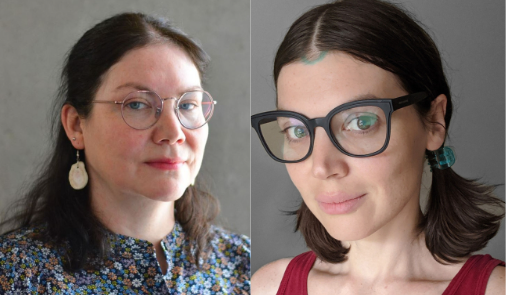Indigenous Learning Forum: "Ukwehuwe Stories: A Philosophy and History of Being in the World" with Jennifer Komorowski and Nyssa Komorowski

The fifth 2023-2024 Indigenous Learning Forum will take place March 21, 2024 at 3:00 p.m. ET on Zoom.
NOTE: These programs are designed as spaces for sharing ideas and works still in-progress. For this reason, this event will not be recorded. This event is open to all but registration is required.
Jennifer Komorowski is an Assistant Professor in the Philosophy Department at Toronto Metropolitan University (formerly Ryerson) where she teaches Indigenous philosophy, psychoanalysis, and aesthetics. She is an active member of the Indigenous Faculty Council at TMU and represents the Indigenous Faculty on the faculty association. She holds a PhD from the Centre for the Study of Theory and Criticism at Western University and her dissertation, “The Masochian Woman: Coming to a Philosophical Understanding of Haudenosaunee Women’s Pain” focuses on Indigenous women’s pain, psychoanalysis, and Indigenous women’s writing. Jennifer is also a member of the Oneida Nation of the Thames, located just outside London, ON.
Nyssa Komorowski is a PhD Candidate at the University of Toronto in Art History and Book History and Print Culture. Her research on Haudenosaunee history and culture informs her dissertation work on the Mohawk-English poetess E. Pauline Johnson Tekahionwake. Currently, she is researching wampum, and the fraught relationships between museums that hold wampum and the Indigenous communities where the wampum originated, to criticize and contextualize Pauline’s use and misuse of wampum in her work. Her aim is to treat wampum in a way that exceeds and escapes the Western material culture framework. She holds an advanced degree in Art from Fanshawe College, a certificate in Photo Arts specializing in dark room processes from Haliburton School of the Arts, a BFA in Cross-Disciplinary Art specializing in Publications from OCAD University, and an MA in Art History and Book History and Print Culture from University of Toronto. As an artist, she seeks ways to incorporate creative praxis into her academic projects. She is a member of Oneida Nation of the Thames and has Polish and English heritage.
This combined philosophical and historical presentation explores how Ukwehuwe developed a philosophy of being in the world specific to Turtle Island by sharing stories, and then demonstrates these philosophies in art, design, and political action. Ukwehuwe nations of the Haudenosaunee Confederacy use stories as a way of passing on culture, language, and knowledge about the world. The Creation Story, the recitation of the Great Law, and the Kalihwiyo or Good Message, are a few of the foundational epics that find expression in stories, and in greetings like the tradition of saying the “words before all others” known as the Thanksgiving Address (Hill 15). For Ukwehuwe, the cosmology “is one of those meta-narratives which seeks to interpret the mysteries of human existence” (Mohawk viii). Thus, storytelling is a way of carrying on many aspects of our culture and who we are, but it also allows us to theorize about the world we live in and “ask[s] the listener to use his/her own mind to see what they think the story means” (xii).
Stories are how our memories live on, and how we continually reshape and reclaim our relations to each other, to the earth, and to our ancestors. It is common to learn about plant medicines and hear how we can understand values like reciprocity in stories like Sky Woman’s journey from Sky World to Turtle Island. However, recitations of story have much more to teach. In stories there is a philosophy that explores how our universe is structured and how things come into relation with one another, not only in the physical sense, but also spanning generations through space and time.
Visual and material production of these philosophies create storied waypoints in history that in revisiting, “posits [our] worldview as fact and connects the variety of experiences into a creation that constitutes [our] individual reality; it is out of this reality that all relationality flows” (Rodriguez and Iakoiane Wakerahkats:teh 21). Through visual consideration of wampum relations, recounting how wampum has been used to resist colonialism, and exploration of beadwork and embroidery, remembering that our stories are present reminds us to be good relatives and become good ancestors, establishing a philosophy of being in the world specific to Turtle Island.
Citations:
Hill, Susan M. The Clay We Are Made Of: Haudenosaunee Land Tenure on the Grand River. University of Manitoba Press, 2017.
Mohawk, John. Iroquois Creation Story: John Arthur Gibson and J.N.B. Hewitt’s Myth of the Earth Grasper. Buffalo, N.Y: Mohawk Publications, 2005.
Rodriguez, Jeanette, and Iakoiane Wakerahkats:teh. A Clan Mother’s Call: Reconstructing Haudenosaunee Cultural Memory. Albany: State University of New York Press, 2017.
